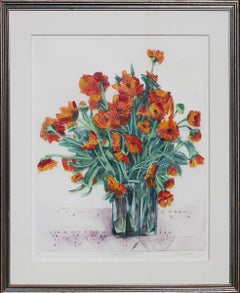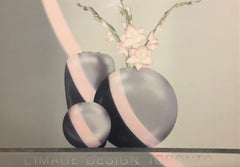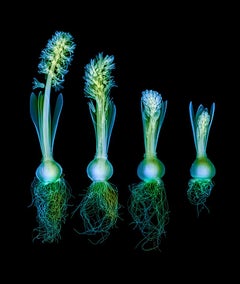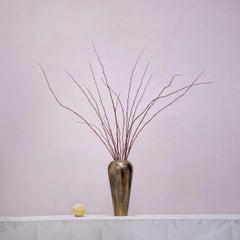Plant Still-life Prints
to
116
252
152
201
114
61
Overall Width
to
Overall Height
to
274
60
32
20
15
15
10
8
5
4
3
1
39
33
32
18
16
114
61
329
276
5
4
5
15
20
54
127
32
95
522
195
63
863
780
704
498
429
384
273
272
239
195
192
186
157
155
139
136
132
131
113
107
208
164
146
120
101
104
279
545
192
Art Subject: Plant
Wallflower 29
Located in Washington, DC
Artist: Donald Sultan
Title: Wallflower 29
Portfolio: Wallflowers
Medium: Screenprint on paper
Date: 2008
Edition: 106/190
Frame Size: 29 3/8" x 26 3/4"
Sheet Size: 24 1/4" x 21 1/2"...
Category
Early 2000s Contemporary Still-life Prints
Materials
Paper, Screen
Abstract Contemporary Interior Still Life Print of Marigolds in a Teal Vase
Located in Houston, TX
Abstract contemporary interior still life depicting Marigolds in a teal glass vase. Signed, titled, and editioned by artist at the bottom. Framed in a...
Category
Late 20th Century Abstract Still-life Prints
Materials
Lithograph
Poster-L'Image Design, Toronto
Located in Chesterfield, MI
Poster. Published by Posters International-Toronto, Canada. Measures 24 x 34 inches Unframed. Good Condition.
Category
Late 20th Century Still-life Prints
Materials
Lithograph
$160 Sale Price
20% Off
Hyacinth Sequence on Black -contemporary black and green inkjet print on paper
By Hugh Turvey
Located in London, GB
Hugh Turvey is a British artist and photographer who uses x-ray technology to create what he calls Xograms, a fusion of visible light and x-ray imagery.
Hugh trained as a designer /...
Category
2010s Contemporary Figurative Prints
Materials
Paper, Inkjet
Red Valerian - print on paper
Located in Burlingame, CA
Willard Dixon archival pigment print featuring minimal pink flower (a Red Valerian flower) in a glass vase. The image is from a still life painting created is 2020. A work on paper i...
Category
21st Century and Contemporary Contemporary Still-life Prints
Materials
Archival Pigment
Still Life with Cue Ball - ltd. ed. print on paper
Located in Burlingame, CA
Willard Dixon archival pigment print featuring minimal flora in a gold vase with cue ball. The image is from a still life painting created is 2020. A work on ...
Category
21st Century and Contemporary Contemporary Still-life Prints
Materials
Archival Pigment
Op.304 Cassiterite, Realgar Malachite, by Jakob Demus
Located in Palm Springs, CA
Op.304 Cassiterite, Realgar Malachite, Diamond drypoint by Jakob Demus. This is a unique print before the edition. The stones were some of many collected by Demus, from which he mad...
Category
1980s Contemporary Still-life Prints
Materials
Drypoint
"Katu-Belluren": A 17th Century Botanical Engraving by Hendrik van Rheede
Located in Alamo, CA
This is a 17th century engraving of a vine spinach plant entitled "Katu-Belluren" by Hendrik van Rheede tot Drakenstein, plate 46 from his 'Hortus Indicus M...
Category
Late 17th Century Naturalistic Landscape Prints
Materials
Engraving
Charles Levier Print
Located in Lake Worth Beach, FL
Artist/Designer; Manufacturer: Charles Levier (French, 1920-2004)
Marking(s); notes: signed in plate
Materials: paper
Dimensions (H, W, D): 22"h, 15.25"w; 32"h, 25.5"w frame
Addition...
Category
20th Century Modern Still-life Prints
Materials
Offset
Red Ferns, Folk Art Lithograph by Mary Faulconer
Located in Long Island City, NY
Mary Faulconer, American (1912 - 2011) - Red Ferns, Year: 1980, Medium: Lithograph, signed and numbered in pencil, Edition: 250, Image Size: 14 x 11 inches, Size: 26 in. x 22.5 ...
Category
1980s Folk Art Still-life Prints
Materials
Lithograph
Butterfly Cup, Folk Art Lithograph by Mary Faulconer
Located in Long Island City, NY
Mary Faulconer, American (1912 - 2011) - Butterfly Cup, Year: circa 1980, Medium: Lithograph, signed and numbered in pencil, Edition: 250, AP 35, Image Size: 16 x 11 inches, Size...
Category
1980s Folk Art Still-life Prints
Materials
Lithograph
Peace & Plenty, Folk Art Lithograph by Mary Faulconer
Located in Long Island City, NY
Mary Faulconer, American (1912 - 2011) - Peace & Plenty, Year: circa 1981, Medium: Lithograph, signed and numbered in pencil, Edition: 250, AP 35, Image Size: 16.5 x 12 inches, S...
Category
1980s Folk Art Still-life Prints
Materials
Lithograph
Strawberry Plant and Figaro, Folk Art Lithograph by Mary Faulconer
Located in Long Island City, NY
Mary Faulconer, American (1912 - 2011) - Strawberry Plant and Figaro, Year: circa 1980, Medium: Lithograph, signed and numbered in pencil, Edition: 250, AP 35, Image Size: 11.5 x...
Category
1980s Folk Art Still-life Prints
Materials
Lithograph
Spring Bouquet, Folk Art Lithograph by Mary Faulconer
Located in Long Island City, NY
Mary Faulconer, American (1912 - 2011) - Spring Bouquet, Year: 1979, Medium: Lithograph, signed and numbered in pencil, Edition: 250, Size: 30 in. x 22 in. (76.2 cm x 55.88 cm), ...
Category
1970s Folk Art Still-life Prints
Materials
Lithograph
Johnny Jump Up, Folk Art Lithograph by Mary Faulconer
Located in Long Island City, NY
Mary Faulconer, American (1912 - 2011) - Johnny Jump Up, Year: 1980, Medium: Lithograph, signed and numbered in pencil, Edition: 250, AP 35, Image Size: 14 x 22 inches, Size: 22...
Category
1980s Folk Art Still-life Prints
Materials
Lithograph
Flowers Rue Jacob, Folk Art Lithograph by Mary Faulconer
Located in Long Island City, NY
Mary Faulconer, American (1912 - 2011) - Flowers Rue Jacob, Year: circa 1980, Medium: Lithograph, signed and numbered in pencil, Edition: 250, AP 35, Image Size: 16.5 x 11.5 inch...
Category
1980s Folk Art Still-life Prints
Materials
Lithograph
Sunflower, by Mark Jenkins
By Mark Jenkins
Located in Palm Springs, CA
From an edition of 25. Photography and digital print.
Based in San Francisco, Mark Jenkins has spent the majority of his career working as a commercial photographer and graphic desi...
Category
21st Century and Contemporary Realist Still-life Prints
Materials
Digital
$280 Sale Price
20% Off
(Title Unknown)-Botanical Print. Printed in Italy
Located in Chesterfield, MI
Botanical Print. Plate-signed. Measures 22.25 x 16.375 in. Unframed. Printed in Italy. Good/Fair Condition. Paper border shows signs of age and handling. Image has an imperfection/cr...
Category
Late 20th Century Still-life Prints
Materials
Lithograph
$120 Sale Price
20% Off
Abolboda; Elodea (Waterweeds); Lepidosperma (Hoary Rapier-Sedge) /// Botanical
Located in Saint Augustine, FL
Artist: Georges-Louis Leclerc, Comte de Buffon (French, 1707-1788)
Title: "Abolboda; Elodea (Waterweeds); Lepidosperma (Hoary Rapier-Sedge)" (Triandrie Monogynie, Plate 905)
Portfoli...
Category
1740s Naturalistic Still-life Prints
Materials
Watercolor, Engraving, Laid Paper, Intaglio
Aesthetic Flower Photography - Memento Mori 1 - By Evangelos Koukouwitakis
Located in Winterswijk, NL
Memento mori is a Latin saying that starts with Remember that you are dying! or in general with a memory of death! translates. The saying is considered a vanitas symbol. Vanitas desc...
Category
21st Century and Contemporary Still-life Prints
Materials
Lithograph
Yellow flags on white
By Alex Katz
Located in Fairfield, CT
Edition of 150.
Category
2010s Contemporary Still-life Prints
Materials
Rag Paper, Etching, Archival Pigment
Poster-Galerie Michael. Century City, Los Angeles
Located in Chesterfield, MI
Poster-Century City, Los Angeles. Nov. 6, 1981 through Nov. 27, 1981. Publishing Information: Southern California Graphics, Culver City. Copyright 1981 Da...
Category
1980s Still-life Prints
Materials
Lithograph
$100 Sale Price
20% Off
Fiji Rose, Graphic Blue and Red Colour Print with Flower, 1973
Located in Kingsclere, GB
Fiji Rose by Philip Sutton, 1973
Additional information:
Medium:lithograph
87 x 68 cm
34 1/4 x 26 3/4 in
signed, dated, titled and inscribed AP in pencil
Philip Sutton is a British...
Category
20th Century Still-life Prints
Materials
Lithograph
Edges 2
By Alex Katz
Located in Toronto, Ontario
Adored by collectors and art lovers around the globe, Alex Katz is renowned for his elegant and distinctive version of figuration.
Born in 1927, Katz has been dedicated to art-makin...
Category
1990s Minimalist Still-life Prints
Materials
Etching
$2,250
“Parasol in Pastel” Poster. Copyright Donald Art Co, 1985.
Located in Chesterfield, MI
Poster. Measures 22 x 28 in. Unframed. Copyright Donald Art Co, 1985. Good Condition (i.e. creasing and indentation).
Category
1980s Still-life Prints
Materials
Lithograph
$120 Sale Price
20% Off
Art of the 80's New York Exhibition-Poster
Located in Chesterfield, MI
PEMA
Art of the 80's, New York Exhibition-Poster. Measures 36 x 24 inches Unframed. Plate Signed. Fair/Distressed Condition.
Category
1980s Still-life Prints
Materials
Lithograph
$100 Sale Price
20% Off
'Botanical Rhapsody' Realistic/Abstract Floral Pattern Photograph Blue/White
Located in Wellesley, MA
"Botanical Rhapsody" by Judith Allen-Efstathiou is an exquisite photographic cyanotype print in deep blue and white of wildflowers abstracted. Highly intricate and lavishly depicted...
Category
2010s Realist Still-life Photography
Materials
Mulberry Paper, Photographic Paper
Isn't This Still Life
Located in Berkeley, CA
Color aquatint, sugarlift and spitbite aquatints.
Paper Size: 29.5” x 22.75”
Edition of 30
Category
2010s Still-life Prints
Materials
Etching
Wildflowers - Screen Print by Franco Bocchi - 1980s
Located in Roma, IT
Wildflowers is a modern artwork realized by Franco Bocchi in 1980s.
Mixed colored screen print.
Hand signed on the lower margin.
Numbered on the lower left margin, ex. 128/200.
...
Category
1980s Contemporary Figurative Prints
Materials
Screen
American Beauty-Limited Edition (AP) Etching with Embossing, Signed by Artist
Located in Chesterfield, MI
Limited Edition (AP) Etching with Embossing, Signed by Artist. The print measures 26 x 20.5 inches and is unframed. The date of creation is unknown, but is believed to be within the ...
Category
Late 20th Century Still-life Prints
Materials
Etching
Wildflowers - Screen Print by Franco Bocchi - 1980s
Located in Roma, IT
Wildflowers is a modern artwork realized by Franco Bocchi in 1980s.
Mixed colored screen print.
Hand signed on the lower margin.
Numbered on the lower left margin. Edition of 200...
Category
1980s Contemporary Figurative Prints
Materials
Screen
Still Life - Screen Print by Leo Guida - 1976
By Leo Guida
Located in Roma, IT
Still Life is an artwork realized in 1976 by the Italian Contemporary artist Leo Guida (1992 - 2017).
Original screen print on cardboard
Hand-signed on the lower right in pencil ...
Category
1970s Contemporary Still-life Prints
Materials
Screen
Still Life - Etching by Leo Guida - 1976
By Leo Guida
Located in Roma, IT
Still Life is an artwork realized in 1976 by the Italian Contemporary artist Leo Guida (1992 - 2017).
Original screen print on cardboard
Hand-signed on the lower right in pencil ...
Category
1970s Contemporary Figurative Prints
Materials
Etching
Wildflowers - Screen Print by Franco Bocchi - 1980s
Located in Roma, IT
Wildflowers is an original modern artwork realized by Franco Bocchi in 1980s.
Mixed colored serigraph.
Hand signed on the lower margin.
Numbered on the lower left margin. Edition...
Category
1980s Contemporary Figurative Prints
Materials
Screen
Blue Rose - Etching by Giacomo Porzano - 1970s
Located in Roma, IT
Blue Rose is a contemporary artwork realized by Giacomo Porzano in 1970s.
Colored etching.
Hand-signed on the lower right.
Numbered on the lower left.
Edition 8/50
Giacomo Porza...
Category
1970s Contemporary Figurative Prints
Materials
Etching
Cosmos-Scene A-2
Located in Palm Springs, CA
Medium: intaglio with monotype background
Image size: 7.75 × 7.75 in (19.7 × 19.7 cm)
Sheet size: 17.75 × 15.25 in (45.09 × 38.47 cm)
Edition of 20
Year: 2022
Tachibana’s prints tak...
Category
2010s Contemporary Still-life Prints
Materials
Intaglio, Monoprint
Les Fleurs #4-Limited Edition Print, Signed by Artist (Signature is Illegible)
Located in Chesterfield, MI
Limited Edition Print (33/80). Pencil-signed by the artist (signature is illegible). Measures 14.75 x 11 inches and is unframed. The print is in Excellent Condition.
Category
Late 20th Century Still-life Prints
Materials
Lithograph
$128 Sale Price
48% Off
Flowerpot - Original Lithograph by Jovan Vulic - 1988
By Jovan Vulic
Located in Roma, IT
Flowerpot is a beautiful colored lithograph on paper, realized in 1988 by the artist Jovan Vulic (b. 1951).
Hand-signed and Artist's proof in pencil on the lower margin.
This co...
Category
1980s Contemporary Figurative Prints
Materials
Lithograph
The Lantern-Poster. Copyright Aaron Ashley, Inc.
By Carolyn Blish
Located in Chesterfield, MI
Poster. Measures 22.5 x 27.75 inches and is Unframed. Good/Fair Condition-signs of wear consistent with age and handling.
Category
Late 20th Century Still-life Prints
Materials
Color
$156 Sale Price
20% Off
Fleurs et Barges-L. E. Print, Signed by Artist (Artist Signature is Illegible)
Located in Chesterfield, MI
Limited Edition Print (34/80). Pencil-signed by the artist (signature is illegible). Measures 15 x 11 inches and is unframed. The print is in Excellent Condition.
Category
Late 20th Century Still-life Prints
Materials
Lithograph
$128 Sale Price
48% Off
Flowers
Located in Fairfield, CT
About the Artist:
Richard Klein is a Connecticut-based artist, curator and writer. As an artist, he has exhibited widely, including the Neuberger Museum of Art at SUNY Purchase; Ca...
Category
2010s Contemporary Still-life Prints
Materials
Paper, Screen
Ancient Roman Fresco - Original Etching by Francesco Cepparuli - 18th Century
Located in Roma, IT
Ancient Roman Fresco, from the series "Antiquities of Herculaneum", is an original etching on paper realized from a design by Cepparuli after Niccolò Vanni in the 18th century.
Sign...
Category
18th Century Modern Figurative Prints
Materials
Etching
Ancient Roman Fresco - Original Etching by Francesco Cepparuli - 18th Century
Located in Roma, IT
Ancient Roman Fresco, from the series "Antiquities of Herculaneum", is an original etching on paper realized from a design by Cepparuli after Nicolò Vanni in the 18th century.
Signe...
Category
18th Century Modern Figurative Prints
Materials
Etching
Flowers - Cromolitograph - Early 20th Century
Located in Roma, IT
Flowers is a beautiful Cromolitografia print, realized by H.Herder.
Good conditions with some rips on the lower margin.
Signed.
The artwork represents beautiful flowers created th...
Category
Early 20th Century Modern Figurative Prints
Materials
Paper, Lithograph
Bouquet of Flowers
By Cornelis Ploos van Amstel
Located in New York, NY
A supberb impression of this extremely scarce and early color etching after Jan van Huysum. With the artist's ink stamp.
Category
1770s Dutch School Still-life Prints
Materials
Color, Etching
The White Prince-Poster. New York Graphic Society. Lithographed in USA
Located in Chesterfield, MI
PAUL DE LONGPRÉ (French, 1855-1911)
The White Prince
Poster/Print
22 x 17 in. Unframed
Plate signed
Copyright New York Graphic Society. Lithographe...
Category
Late 20th Century Still-life Prints
Materials
Lithograph
Flowers 7, Modern Lithograph by Ira Moskowitz
Located in Long Island City, NY
Ira Moskowitz, Polish/American (1912 - 2001) - Flowers 7, Year: circa 1979, Medium: Lithograph, signed and numbered in pencil, Edition: 250, AP, Size: 30 x 21 in. (76.2 x 53.34 cm...
Category
1970s Modern Still-life Prints
Materials
Lithograph
$480 Sale Price
20% Off
"Shell Ginger, " Color Serigraph Still Life signed by Hunt Slonem
By Hunt Slonem
Located in Milwaukee, WI
"Shell Ginger" is an original color serigraph by Hunt Slonem. The artist signed the piece in the lower right, titled it lower center, and wrote the edition number (A.P. 16/30) in the lower left. It depicts a chair with an animal skin and plants.
25"x 20 3/8" image
30"x 22" paper
33 1/2 x 28 3/4" frame
Hunt Slonem (born Hunt Slonim, July 18, 1951) is an American painter, sculptor, and printmaker. He is best known for his Neo-Expressionist paintings of tropical birds, often based on a personal aviary in which he has been keeping from 30 to over 100 live birds of various species. Slonem's works are included in many important museum collections all over the world; he is exhibiting regularly at both public and private venues, and he has received numerous honors and awards.
Hunt Slonem’s oil paintings...
Category
1980s Still-life Prints
Materials
Screen
French Contemporary Photo by Jean-Michel Rousvoal - Butinage
By Jean-Michel Rousvoal
Located in Paris, IDF
Title: Butinage
Size: 97x130 cm (without frame) / $3,000 - 112x144cm (with frame) / $3,400
Printed art print on Epson printer with Epson pigment inks. This art print is the number ...
Category
2010s Contemporary Still-life Prints
Materials
Varnish, Pigment, Canvas
Apothesis of a Pine Tree-Poster. New York Graphic Society
Located in Chesterfield, MI
Poster. New York Graphic Society Ltd. Printed in U.S.A. Measures 35 x 24 inches and is Unframed. Good/Fair Condition.
Category
1970s Still-life Prints
Materials
Lithograph
$172 Sale Price
20% Off
Les Fleurs-Limited Edition Print, Artist Signature is Illegible
Located in Chesterfield, MI
Limited Edition Print (35/80). Pencil-signed by the artist (signature is illegible). Measures 14.75 x 11 inches and is unframed. The print is in Very Good Condition.
Category
Late 20th Century Still-life Prints
Materials
Lithograph
$200 Sale Price
20% Off
Flowers
Located in Fairfield, CT
About the Artist:
Richard Klein is a Connecticut-based artist, curator and writer. As an artist, he has exhibited widely, including the Neuberger Museum of Art at SUNY Purchase; Ca...
Category
2010s Contemporary Still-life Prints
Materials
Paper, Screen
$1,440 Sale Price
20% Off
Poster-Daniel Wolf Inc. New York, Photographs-October 7-November 1, 1980
Located in Chesterfield, MI
SHEILA METZNER (American, b. 1939). Poster-Daniel Wolf Inc. New York, Photographs, October 7-November 1, 1980. Measures 28 x 20 in. Unframed. Good/Fair Condi...
Category
1980s Still-life Prints
Materials
Lithograph
Le Fleurs #3-Limited Edition Print, Artist Signature is Illegible
Located in Chesterfield, MI
Limited Edition Print (66/90). Pencil-signed by the artist (signature is illegible). Measures 15 x 11 inches and is unframed. The print is in Very Good Condition.
Category
Late 20th Century Still-life Prints
Materials
Lithograph
$200 Sale Price
20% Off
Azaleas on Yellow, from The Flowers Portfolio
By Alex Katz
Located in London, GB
Archival pigment print, 2021, on Innova Etching Cotton Rag 315 gsm paper, signed in pencil, numbered from the edition of 100, Lococo Publishing, Missouri, 119 x 86 cm. (46¾ x 33¾ in.)
Category
2010s Contemporary Still-life Prints
Materials
Archival Pigment
Dark Flora #, Horsetail, A floral arrangement of wild plants and flowers
Located in London, GB
Dark Flora #6 – Horsetail: Foraged from a damp, boggy area of woodland in mid-summer. It includes Horsetail (Marestail), buckthorn, mallow, tutsan berry, blackberry and heather.
I s...
Category
2010s Contemporary Still-life Photography
Materials
Archival Pigment
Gochka Charewicz - Herbarium - Original Signed Lithograph
Located in Collonge Bellerive, Geneve, CH
CHAREWICZ Gochka (XXe)
Michel Butor's Herbarium
Signed and numbered 2/29
Dimensions: 42 x 32 cm. Toutes marges.
Category
1980s Modern Still-life Prints
Materials
Lithograph
"Sunny Day", Color Nature Print, Yellow Flowers, Graphic Design
Located in New York, NY
"Sunny Day" Color Nature Photography by Shooting Star Designs
Archival pigment print on museum fine art paper
Edition of 7
Includes certificate of authenticity. Signed and numbered ...
Category
2010s Contemporary Landscape Prints
Materials
Color, Archival Pigment
Untitled 29
Located in New York, NY
Cyanotype (Unique)
Signed, titled, and dated in pencil, verso
This artwork is offered by ClampArt, located in New York City.
These cyanotype prints of botanical specimens were made by artist Pipo Nguyen-duy in Claude Monet’s garden...
Category
1990s Contemporary Still-life Prints
Materials
Color
Untitled F36
Located in New York, NY
Cyanotype (Unique)
Signed, titled, and dated in pencil, verso
This artwork is offered by ClampArt, located in New York City.
These cyanotype prints of botanical specimens were made ...
Category
1990s Contemporary Still-life Prints
Materials
Color
Recently Viewed
View AllMore Ways To Browse
Nandi Bull
New England Church Painting
Newfoundland Dog Art
Newport Rhode Island Paintings
Norman C Black Painting
Norman Prescott
Norval Morrisseau
Notorious Big
Nude Scape
O T Clark
Oasis Vintage Poster
Octavius Clark
Oil Painting Constantinople
Oil Painting Dog Sleeping
Oil Painting In Bone
Oil Painting Steamship
Oil Painting With Computer
Oil Thomas Creswick




